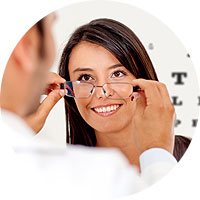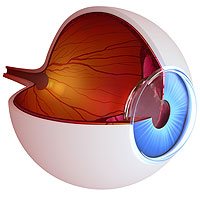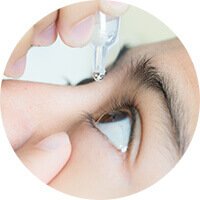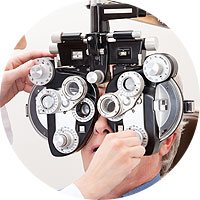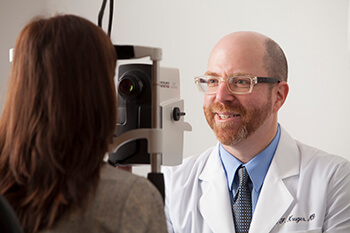 The retina is an extremely important part of the eye. A healthy retina is essential for clear vision. Unfortunately, the retina is prone to many different conditions, some common and some not so common. No matter the condition, rest assured that you are in good hands at Eye Care Specialists.
The retina is an extremely important part of the eye. A healthy retina is essential for clear vision. Unfortunately, the retina is prone to many different conditions, some common and some not so common. No matter the condition, rest assured that you are in good hands at Eye Care Specialists.
The retina is the light-sensitive patch of tissue at the very back of the eye. The retina is photosensitive – it takes the light that comes into your eye through your pupil and turns it into signals for the brain. These signals travel through the optic nerve up to the brain and turn into the images you see!
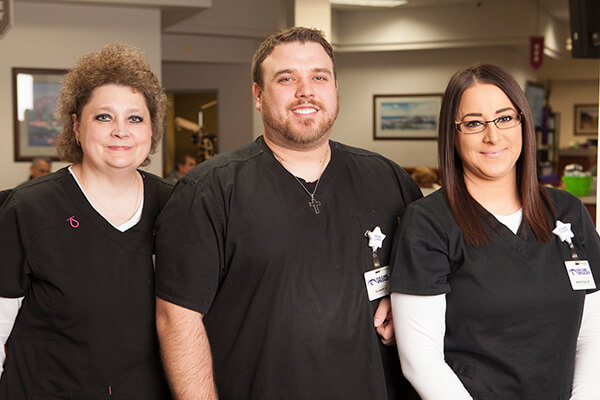
At Eye Care Specialists, we have trained optometrists and ophthalmologists who are able to diagnose and treat a wide range of retinal disorders. Some common retinal disorders include:
- Retinal Tears/Detachment. Retinal tears can happen with age or trauma. Either way, it is important to get retinal tears fixed as soon as possible so they don’t lead to retinal detachment. A retinal detachment is considered a medical emergency and should be treated immediately to save vision.
- Diabetic Retinopathy. One of the leading causes of blindness in the United States, diabetic retinopathy occurs in diabetics who don’t maintain healthy blood sugar levels. High blood sugar levels cause blood vessels on the retina to leak, blocking vision.
- Macular Degeneration. Vision loss is common in those who suffer from macular degeneration. It can cause distorted, patchy and blurry vision that can make driving and reading difficult.

At Eye Care Specialists, we have highly skilled retinal surgeons ready to do what they can to save your vision. The retina is a sensitive tissue, so it is important to go to a surgeon that you trust.
Common retinal treatments include vitrectomy, laser surgery, cryopexy and scleral buckle. Your Eye Care Specialists surgeon will be able to determine which treatment is best for your condition.
If you suspect you may have a retinal condition, or if you have been diagnosed and are searching for treatment, call us as soon as possible!
EYLEA HD was recently approved by the FDA for treatment of Wet Age-Related Macular Degeneration (WAMD), Diabetic Macular Edema (DME), and Diabetic Retinopathy. Patients can now receive less frequent injections after their initial monthly does while receiving the same visual improvements and safety and effectiveness of EYLEA. We’re excited to offer this new advancement in the treatment of patients with serious retinal diseases. Call (888) 685-2771 to schedule your appointment with Dr. Andrews or Dr. Kruger.
Unfortunately, macular degeneration cannot be cured; however, there are treatments available that can slow the progression down to retain as much of your vision as possible. Dry macular degeneration is much easier to manage than wet macular degeneration.
Glaucoma and macular degeneration can happen simultaneously and affect a greater part of your vision than one of these diseases alone. Since glaucoma affects the sides of your vision and macular degeneration affects the central vision, these two could lead to complete vision loss if developed simultaneously.
Depending on what state you live in and how far your macular degeneration has progressed, you can drive with macular degeneration. It’s imperative to get your eyes checked by a professional if you begin to develop blind spots or blurry vision from macular degeneration.
Although there are many ways to prevent or delay the effects of diabetic retinopathy, there is no cure. By getting your eyes routinely checked, you can stay ahead of this eye disease and treat it more effectively.
Diabetic retinopathy shows no symptoms until it begins to affect your vision. By this point, the disease has become severe. Symptoms may include
- Floaters or spots in vision
- Blurry vision
- Vision loss
- Blind spots in your vision
- Pain or pressure in the eye
There are four stages of diabetic retinopathy,
1. Mild nonproliferative diabetic retinopathy
Blood vessels of the retina begin to swell. Fluid can also leak into the retina during this stage, causing the macula to swell.
2. Moderate nonproliferation diabetic retinopathy
Blood vessels of the retina swell to the point of interfering with the blood flow to the retina. This leads to the macula accumulating blood & fluids.
3. Severe nonproliferation diabetic retinopathy
Blood vessels in the retina become so blocked that the body receives signals to grow blood vessels in the retina.
4. Proliferative diabetic retinopathy
Blood vessels begin to form in the retina. These fragile vessels can break easily, leading to a higher risk of fluid leakage and vision problems.
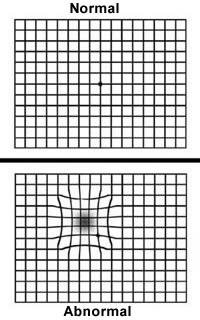 The Amsler grid is a tool that our eye doctors use to detect vision problems. It is helpful in detecting problems with the macula (the central part of the retina) or the optic nerve. An early diagnosis often means early treatment.
The Amsler grid is a tool that our eye doctors use to detect vision problems. It is helpful in detecting problems with the macula (the central part of the retina) or the optic nerve. An early diagnosis often means early treatment.
How To Use The Amsler Grid Test
Testing your eyes with an Amsler grid is easy and takes only a few minutes. Here are the basic steps:
- Test your eyes under normal room lighting used for reading.
- Wear eyeglasses you normally wear for reading.
- Hold the Amsler grid approximately 14 to 16 inches from your eyes.
- Test each eye separately: Cover one eye with your hand while testing the other eye.
- Keep your eye focused on the dot in the center of the grid and answer these questions:
- Do any of the lines in the grid appear wavy, blurred or distorted?
- Do all the boxes in the grid look square and the same size?
- Are there any “holes” (missing areas) or dark areas in the grid?
- Can you see all corners and sides of the grid (while keeping your eye on the central dot)?
- Switch to the other eye and repeat.
IMPORTANT — Report any irregularities to your eye doctor immediately. You can even mark areas of the Amsler grid that you’re not seeing properly (print two grids if you notice problems in each eye), and bring the grid(s) with you when you visit your eye doctor at Eye Care Specialists.











